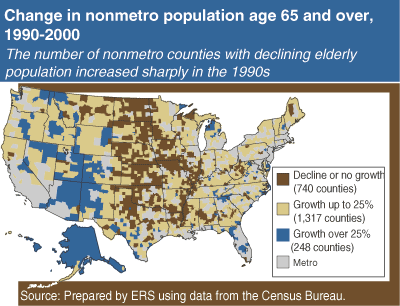Growth of Older Population Slows in Rural and Small-Town Areas
- by Calvin L. Beale
- 11/1/2003
The older rural and small-town population grew more slowly in the 1990s than did the population under age 65, for the only time in the entire 20th century. This stemmed not from a drop in the rate of urban retirees moving to rural (nonmetro) areas, but from fewer people reaching age 65 as a result of the low birth rates of 1925-35. Such a change in the size of the older population has a considerable impact on the provision of health care and other needed services for the elderly.
The increase in rural population under age 65 was distinctly higher in the 1990s (8.5 percent) than during the 1980s (2.6 percent), but the opposite was true for those 65 and older (7.4 percent compared with 16.0 percent in the 1980s). Many retirees continued to move from large city and suburban (metro) areas into nonmetro communities. But growth of the older population from natural increase—that is, from the aging-in-place of late middle-aged persons, minus the deaths of existing older people—was very low in the 1990s.
Natural increase of the older population is affected not only by the birth rate 65 to 74 years earlier, but also by migration of people of that generation over time. Rural residents born during 1925-35 came of age after World War II in an era of rapid and prolonged modernization of agriculture. This led to much farm consolidation and a major drop in the number of farms. Literally millions of people, especially young adults, left farms and surrounding small towns. In hundreds of the most rural counties, the small birth cohorts of 1925-35 were so reduced by outmigration that as they reached age 65 in the 1990s they were outnumbered by deaths of existing older people.
In the 1990s, a third of all nonmetro counties (740) declined in their older population. Declines were most common in the Great Plains, Corn Belt, and Mississippi Delta, which still depend strongly on agriculture. In contrast, in 248 counties the older population continued to grow rapidly—25 percent or more. These counties are primarily in the West, where both natural increase and retirement continue to be high, but also include popular retirement locations elsewhere.
The slower growth of the older population will continue through 2005. But this is just an intermission until survivors of the higher birth groups of World War II and the subsequent “baby boom” reach age 65 after 2010. This event may not be enough to increase the number of older people in all farming counties, but it should lead to major resumed growth of the nonmetro elderly elsewhere.
This article is drawn from:
- Recent Trends in Older Population Change and Migration for Nonmetro Areas, 1970-2000. (2002). USDA, Economic Research Service. Rural America, Vol. 17, Issue 3..


